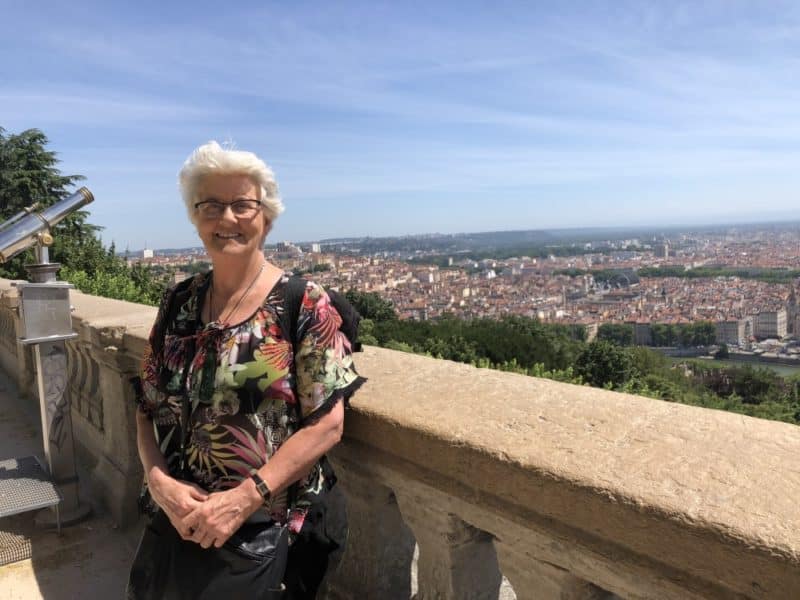Nationally acclaimed quilter Merrilyn George, the creator of the widely exhibited collection of 21 quilts called Set Apart depicting the life of Venerable Suzanne Aubert, has finally visited these places expressed in her art. Originally Mrs George hoped for an organised group tour to visit Mother Aubert’s birthplace in Lyon in France, but when this tour didn’t eventuate because of insufficient numbers, Mrs George wasn’t deterred.
“I just wanted to have a picture of it,” she said.
The carefully planned itinerary included catching up with extended family in the UAE, England, Ireland and the Netherlands as well as visiting places significant to Suzanne. Plucking up the courage to become a sole pilgrim, she left her home in Ohakune for six weeks.
Inspired by the life’s work of Mother Aubert amongst the Māori and the needy, Mrs George was a foundation member of the Associates of Suzanne Aubert — Te Hunga Wahi i nga
Akoranga a Suzanne in 2012.
The pilgrimage proper started in Lyon in France. Marie Henriette Suzanne Aubert was born on June 19, 1835, in St Symphorian de Lay near Lyon.
“I walked the 798 steps to reach the hilltop Basilica of Notre-Dame de Fourviere in Lyon, where Suzanne would have visited and to look out across the city,” Mrs George said.
Sitting in the smaller side Virgin Mary’s Chapel, where Suzanne’s mother Clarice was healed of cancer, was particularly special.
In the crypt, Mrs George was thrilled to see the “Hail Mary” in Te Reo amongst other images and languages from around the world.
During her week-long stay, Mrs George went to morning Mass at St Nizier’s church in central Lyon. Suzanne’s family shifted near here when she was five and this became her parish church until she left for New Zealand when she was 25 in 1860.
“As I walked from Fourviere to St Nizier’s, I looked back to the hill and could just imagine Suzanne seeing and looking up at the Basilica. It stands out on the sky line,” Mrs George said.
Getting to know the rosary group there, she showed the members some quilts from her “Set Apart” collection to tell the story of their once parishioner who is now New Zealand’s “Saint in the Making” and of her influence in New Zealand society. She gifted them a watercolour of Mother Aubert painted by artist Noleen Sommerville from Cambridge.
It was a very special trip to Ars sur Formans where Suzanne visited St Jean-Vianney (the Cure d’Ars) who became Suzanne’s spiritual guide in her early 20’s. This priest prophesied her future work and journey to Jerusalem/Hiruharama on the Whanganui River and the establishment of New Zealand’s first indigenous religious Congregation, the Daughters of Our Lady of Compassion.
A stopover in Paris reminded Mrs George of Mother Aubert going there briefly in 1913, but Suzanne was keen to get to Rome without too much time “on French soil”.
Travelling on to Rome for nine days, Mrs George hoped that she wouldn’t get stuck there as Mother Aubert was. Suzanne arrived in Rome in 1913 from New Zealand to secure her congregation. However World War 1 broke out Merrilyn George with the French city of Lyon beyond. and she had to stay there for six years and through two popes before finally
securing the Decree of Praise in 1917. Mother Aubert called Rome “The land of Taihoa” reflecting the frustration with the red-tape of Vatican officials. She then returned home to Wellington and died aged 91 in October, 1926.
Mrs George sought out the tombs of both Popes Pius X and Benedict XV and prayed there.
During Mother Aubert’s time in Rome, she visited 325 Churches and ate frugally — with onions being a large part of her diet. Mrs George couldn’t match that on the church visiting and deciding not to live on onions, but cut back on pizza and gelato instead!
The Basilica of Santo Maria in Aracoeli is home to the chubby-faced Santo Bambino (a statue of the child Jesus). Mrs George met a local who showed her pictures of this treasured statue as it would have been in Mother Aubert’s time. Mother Aubert visited the figure regularly and it became a symbol for the work that awaited her withunwanted babies and children of little account.
Returning home on July 15, 2018, Mrs George’s appreciation of those early French missionaries has deepened.
“The Catholic Faith we have in New Zealand began with these men and women and our Venerable Suzanne did so much to improve living for many people with her initiatives. She had so much energy and she has been very present with me on this trip.”

Reader Interactions